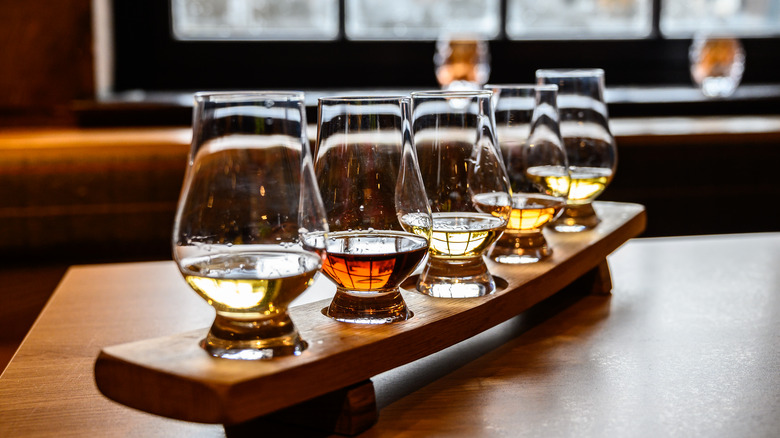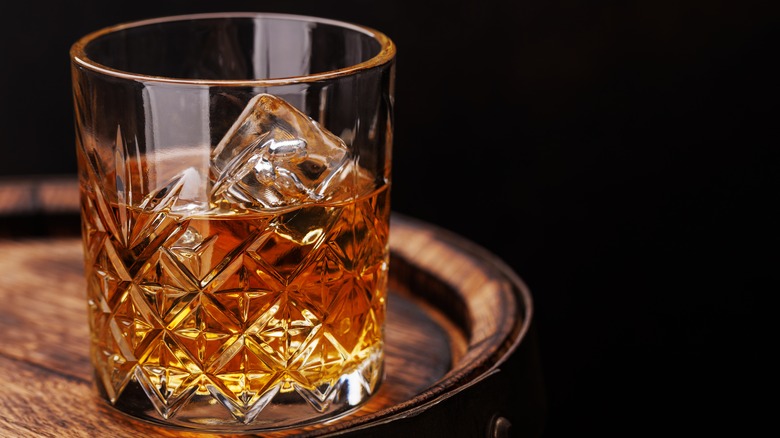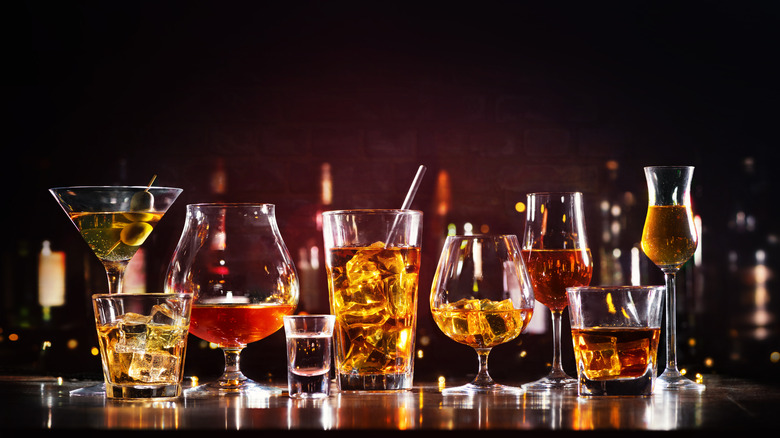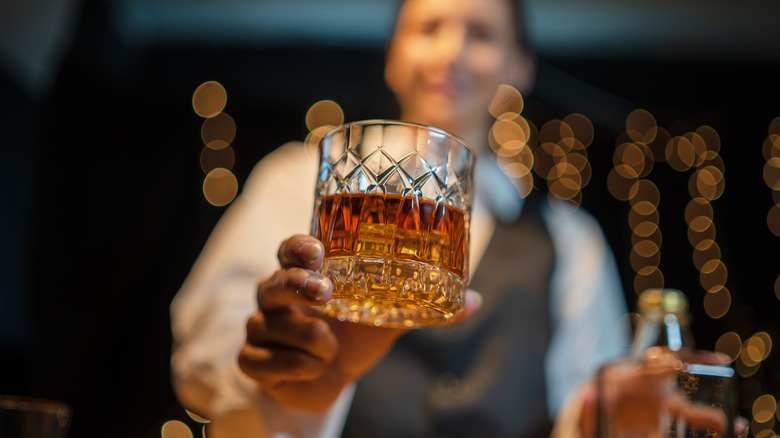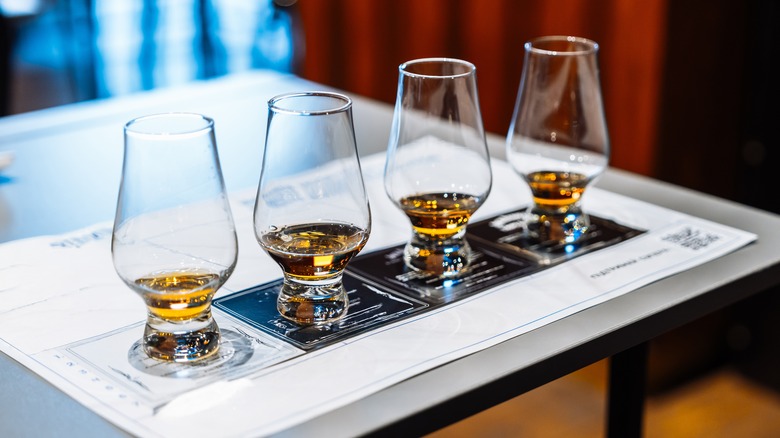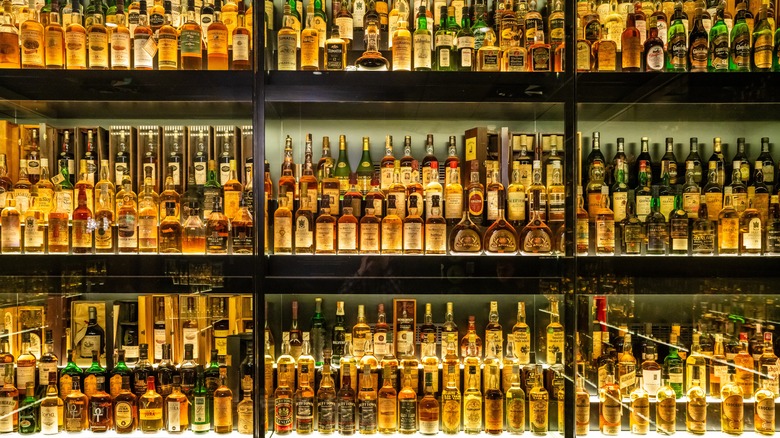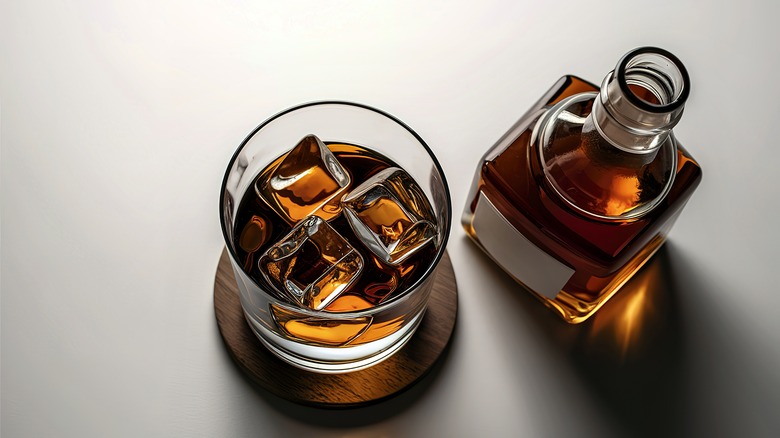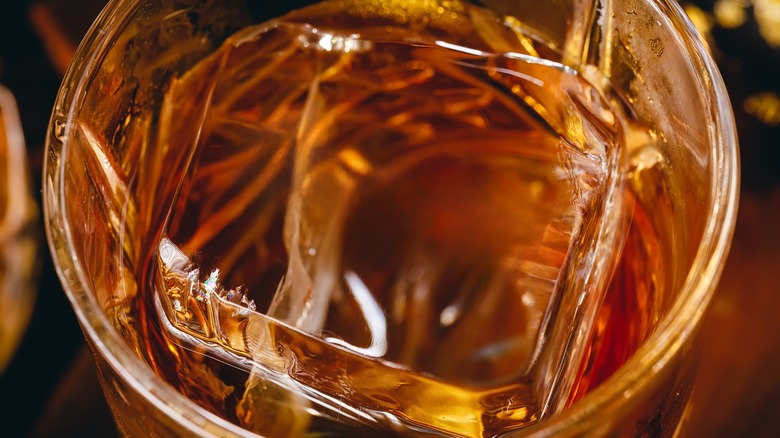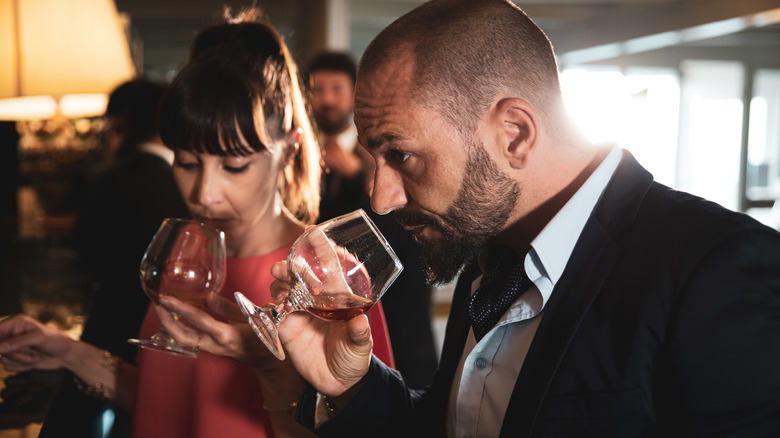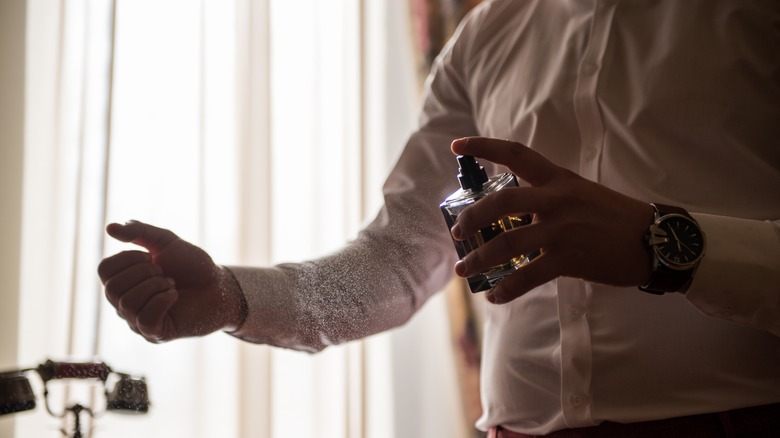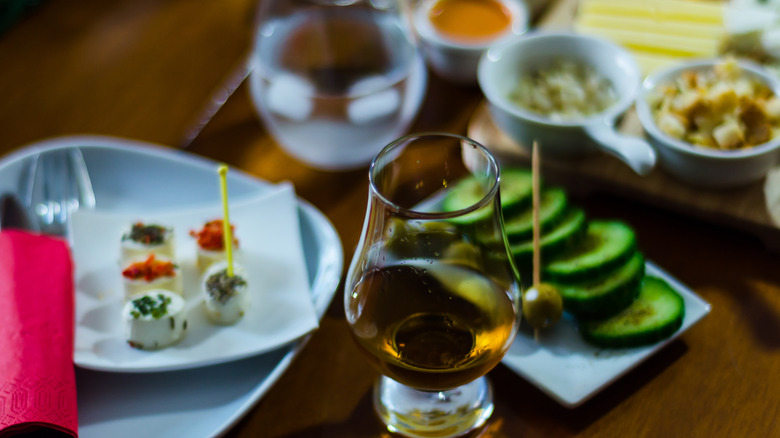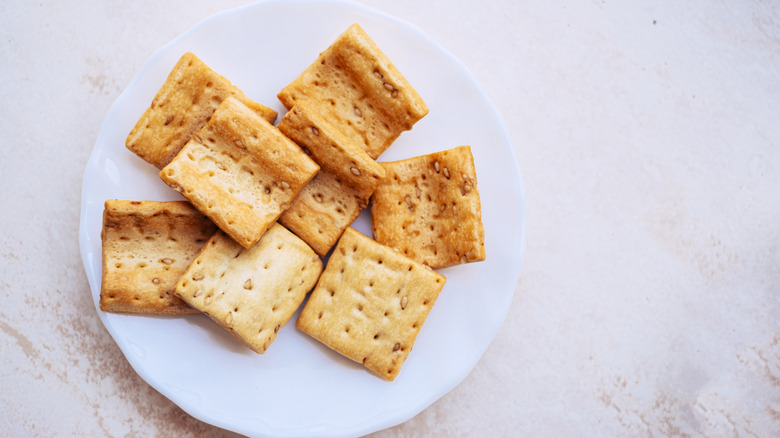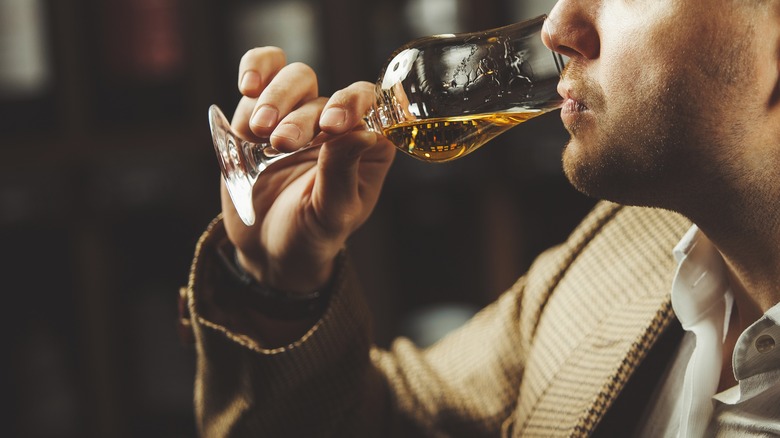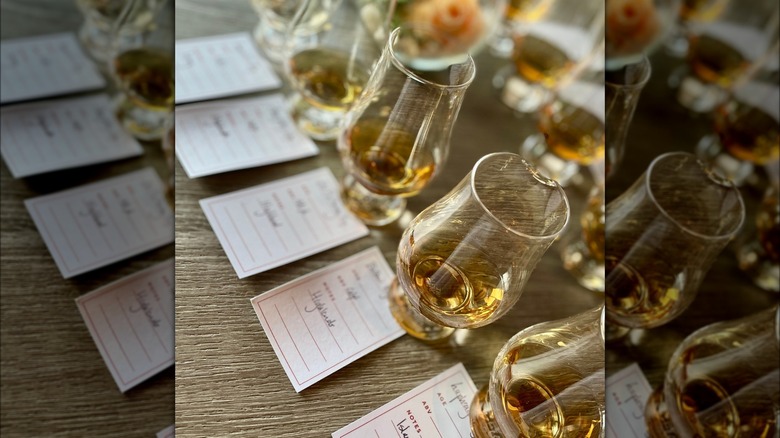13 Common Whiskey Tasting Mistakes To Avoid
Whiskey can be intimidating. It's not typically an introductory spirit for most. To those who have yet to discover its magic, it can seem too abrasive, too bold, too much. However, if you've ever purchased an expensive bottle of whiskey thinking you'll have a drink or two to celebrate something special, or if you've ever attended a whiskey tasting at a distillery only to take one sip and recoil...well, it might not be entirely the whiskey's fault.
Getting the most out of a whiskey tasting experience requires taking a few precautions and following several key guidelines — precautions and guidelines that might not be imparted to you even if you're tasting in a formal setting. To get the lowdown on every whiskey tasting mistake that's far too common, we spoke with a handful of distilling and whiskey experts. If you want to get the most from every sip of whiskey — whether you're a long-time aficionado enjoying a new bottle at home, or you're headed to your very first distillery tour — they suggest you avoid making these common whiskey tasting mistakes.
Not letting the whiskey breathe
You pour a finger or two of whiskey into a glass and are eager to start sipping. Not so fast — good things come to those who wait. Just as experts might tell you it's vital to let your wine breathe before enjoying, you should let your whiskey breathe, too.
According to John Campbell, COO and master distiller at Sespe Creek Distillery in Oxnard, California, you should ideally let your whiskey breathe at room temperature for an hour after that initial pour. "Letting the whiskey breathe will allow some amazing things to happen," he explained. "Firstly, you will start to smell the aromas elevating from the glass that are seeping into the room. This will subconsciously and consciously prepare your palate for what's to come. This will also help to heighten both your expectation and sensitivity, which in turn allows for a much better experience."
Justin Horrillo, Wyoming Whiskey's barrel house manager, seconds this notion, saying that letting whiskey breathe for even just a minute can result in drastic changes in both aroma and flavor. In some cases, you may even notice the whiskey is a little smoother (aka, easier to drink for the newbies in the room) after you let it breathe.
Picking the wrong glass
You wouldn't drink wine out of a tumbler or rocks glass, so why would you choose just any ol' glassware from your bar cart when enjoying whiskey? Ted Dumbauld, founder and distiller at SoNo 1420, recommends reaching for a tulip-shaped glass when tasting whiskey, as the shape will concentrate the whiskey's aromas.
Not only do you need to pick the right glass for your whiskey tasting, but if you're tasting multiple whiskeys at once, you should also use the same type of glass for each whiskey in the tasting. According to Murphy Quint, master blender at Cedar Ridge Distillery in Swisher, Iowa, "The shape of the glassware has an impact on the flavor, and even more so, the aroma of whiskey. So, if you taste a whiskey in a rocks glass and compare it against a whiskey in a Glencairn, you won't be able to make a true, apples-to-apples comparison of the two spirits."
You have several options when it comes to picking glassware specifically for whiskey. The Glencairn is a tapered glass designed specifically for drinking scotch. The Copita is a tulip-shaped glass that looks almost similar to a small wine glass. A rocks glass is what you'd typically get if you were out and ordered an Old Fashioned.
Not going into the tasting blind
Admittedly, it may be difficult to do a blind taste if you're tasting whiskey at home (as you are, after all, presumably the one buying and pouring your own whiskey). However, if you can pull it off, you may very well be rewarded.
According to Stephen Julander, senior operations manager at Woody Creek Distillers in Basalt, Colorado, "Having minimal previous knowledge gives [you] a completely honest opinion of the spirit, without external influence. The look of the bottle, the label, knowledge of the grain bill, the age, the barrel, location, or even the reputation of the distillery can give [you] preconceived notions before you even have given the spirit a taste."
In other words, tasting whiskey blind could just help you uncover a new favorite whiskey or type of whiskey, without the interference of pesky things like brand reputation. Consider hosting an experimental blind whiskey tasting at home by enlisting a few other whiskey fans or whiskey-curious, and preparing tastings for one another.
Tasting whiskey in the wrong order
If you're not tasting your whiskey blind, you'll want to pay careful attention to the order in which you taste the whiskey, according to Justin Horrillo. At formal tastings, you'll find that whiskeys are often laid out from lightest to most intense, left to right.
"As a general rule, start with lower-proof whiskeys and work your way up to higher proofs. If the proofs are similar, begin with lighter flavor profiles such as vanilla, honey or floral notes, then move toward the bolder, richer ones — think dark fruit, tobacco, and leather," Horrillo said.
Additionally, some say that you should taste the "best" whiskey in the batch first. This is because the more whiskey you taste, the more likely your taste buds will become desensitized. If you really want to get the full experience from a higher-priced or higher-quality whiskey, go ahead and enjoy it right off the bat. Then, you can work your way from highest quality to lowest quality.
Assuming a higher price tag means a better whiskey
However, when considering what a "best" whiskey might be, don't let the price tag alone guide your judgement. Part of enjoying whiskey is drinking what you actually like, not what you feel you should prefer based on brand or cost. As Justin Horrillo noted, "Taste is always a matter of personal preference. You might find that a more affordable bottle suits your palate better than a top-shelf one, and that's perfectly fine."
Ashley Frey, co-founder of Frey Ranch, concurred, saying that the most expensive bottles aren't necessarily the best. In fact, many cheap whiskeys are surprisingly tasty, whether you want a cheap bourbon that's worth buying, a rye whiskey, an Irish whiskey, or one of the various offerings from notable Canadian brands like Crown Royal.
If you're really unsure of how to tell a "good" whiskey apart from a bad one, and you don't feel comfortable relying on your personal preferences or the price tags at the liquor store, rely on the whiskey's aroma. If you can sniff (or "nose") a whiskey for multiple minutes and detect nuances in the aromas and complex layers — versus smelling mostly alcohol — you probably have a high-quality whiskey on your hands.
Thinking you should never add water to whiskey
It's a misconception that adding water to whiskey is a big no-no. While those new to the world of whiskey may add a little splash of water to their drink for easier sipping, experts agree that doing so can actually be quite helpful when tasting, too. "A small amount of water, especially in higher-proof whiskeys, can enhance the experience by opening up hidden aromas and rounding out the edges," said Justin Horrillo. "I always recommend trying your whiskey neat first, then adding a drop of water to see how it changes."
That said, Ted Dumbauld cautions not to add too much water to your whiskey right away. Again, he recommended starting with your whiskey neat, then adding a few small drops of water. You can ensure you're not adding too much water to your whiskey at once by using a pipette or a straw, and you'll know that you've added enough water when the alcohol notes in the whiskey diminish and you're able to taste the spirit's fuller flavors.
Tasting whiskey at the wrong temperature
Just because you're adding water to your whiskey, that doesn't mean ice is automatically an approved addition as well. According to Ashley Frey, you don't want your whiskey to be too warm or too cold, and ice can numb your whiskey's aroma. Ted Dumbauld adds that chilling can mute your whiskey's flavor, too. Frey recommends drinking your whiskey at about 60–65 degrees Fahrenheit.
Of course, outside of a whiskey tasting, there are some instances when you might want to drink your whiskey at a temperature lower or higher than room temperature. For example, the hot toddy, made with whiskey, honey, lemon, and spices, is a wintertime classic for good reason. Similarly, if you're going to make Polish whiskey, you'll gently heat your whiskey over the stove with water, honey, sugar, and spices.
If you want to go the other way and drink your whiskey cold, avoid ice, which can severely water down your drink. Additionally, you might want to avoid whiskey stones, which look great but can potentially damage your glassware. Instead, cool whiskey in a wine fridge.
Taking a big sniff of your whiskey
You may already know that you're supposed to sniff your whiskey before you sip it, but it's not as straightforward as all that. Adam Polonski, co-founder and head of whiskey sourcing at Lost Lantern Whiskey in Vermont, says that you should spend a few seconds smelling the whiskey before you drink, specifically while keeping your mouth open. Additionally, he noted that if you're sampling multiple whiskeys in one sitting, you should "nose" (or smell) all of the whiskeys first, before moving on to any actual tasting. "This will give you a quick sense of the similarities and differences between them," he said.
Ashley Frey further recommends you avoid taking a big sniff of the whiskey, as that will just lead to ethanol burn. Instead, she says, "Take short, gentle inhales with your mouth slightly open; move the glass under your nose rather than jamming your nose in."
Wearing a strong scent to a whiskey tasting
You could be making a whiskey tasting mistake before you even leave the house. Yes, what you wear could negatively impact your whiskey tasting experience. According to Ted Dumbauld, wearing an aggressive perfume or cologne can overwhelm your nose. Additionally, Tim Heuisler, global ambassador for the James B. Beam Distilling Company, said that beyond avoiding strong perfumes or colognes, you should take further measures to ensure you're in a "relatively neutral-smelling setting." So, don't have any candles or prepared food nearby.
Luckily, if there is a scent that's impacting your ability to really take in a whiskey's full aromas, those in the wine and spirits industry have a few tricks to "reset" your nose. One is to sniff the back of your hand or some coffee beans. This can help recalibrate your olfactory system so you can go back to "nosing" without overwhelming your sense of smell.
Eating spicy or strong foods before a whiskey tasting
Additionally, you should take care not to distort your palate ahead of a whiskey tasting, Ted Dumbauld said. Avoid eating particularly spicy or strong foods right before a whiskey tasting — that means no going out for buffalo chicken wings or vindaloo before you head to the nearest distillery.
That doesn't mean you need to stick to boring, bland foods only. If you're looking for the best snacks to serve during an at-home whiskey tasting, you have plenty of scrumptious (and, frankly elegant) options. Additionally, some snacks can even enhance your whiskey-tasting experience. For example, what could go better with whiskey than a charcuterie or grazing board? Pair a mild cheddar, creamy brie, or Gouda with a sweet or mild whiskey. Try walnuts with milder whiskeys. For stronger, smokier whiskeys, you can amp up the flavors with nuts such as almonds, pecans, and pistachios, or stronger cheeses like Roquefort. As for the meats on display, try beef tartare or carpaccio. A range of chocolate also pairs very well with whiskey, as do dried fruits.
Failing to reset your palate between whiskeys
With all this noshing and tasting, you'll need to reset your palate between whiskeys, especially if you want to take a more serious, scholarly approach to your whiskey tasting (versus the let's-just-drink-great-bourbon-and-eat-snacks approach). Tim Heuisler said that simply water and table crackers can cleanse your palate effectively if you're tasting multiple whiskeys in one sitting. Other favorite mild foods to keep on hand for palate-cleansing include plain bread and celery.
Before you even begin tasting, though, you might want to take an extra step in prepping your palate for that initial sip of whiskey. A light cocktail or lower ABV spirit can warm up your palate so it's ready to perform in the main event.
Then, when you do begin tasting, don't rush things. As Sienna Jevremov, head distiller at Widow Jane Distillery, advised, "Try to devote an equal amount of time to enjoying each sip. I always taste whiskey slowly and take time to explore its flavors and textures as they develop. I like to give myself time to savor it over time, as it opens in the glass and both the nose and flavors evolve."
Describing whiskey as smooth
We definitely wouldn't blame you if, before your very first whiskey tasting out in public, you quickly Googled some common whiskey tasting terms — just so you can sound like you know what you're talking about. However, don't latch onto just any whiskey-related buzzword. Dumbauld says there's one over-used whiskey descriptor that's a sign of a true novice, and that's "smooth."
What words should you use to describe your whiskey-tasting experience? According to some of the experts we spoke to, you should feel free to speak your mind. As Mark Shilling, president at Maverick Distilling, said, "The top mistake people make when tasting whiskey is letting someone else tell them what they are, or should be, tasting."
On a similar note, Phil Steger, founder and CEO of Brother Justus Whiskey Company, said, "The biggest mistake I see people make when whiskey-tasting is limiting themselves to just one sense or to just analyzing flavors. It's not their natural instinct, but they heard it from somebody somewhere that that's how they're 'supposed' to taste whiskey. ... My advice is to use all your senses, notice everything, and let your mind, memory, sensation, and imagination flow wherever the spirit leads."
Being intimidated by tasting notes
Lastly, don't get bogged down by tasting notes. As Tim Heuisler explained, some people may just have a different whiskey vocabulary than you, and there's no wrong way to describe what you're smelling or tasting.
Murphy Quint agreed: "The number one mistake people make when tasting whiskey is worrying about what they're supposed to taste. Whiskey can be an intimidating category to get into, and there is a lot of snobbery. My advice is to do your best to block that out and just enjoy the experience."
While, sure, Sienna Jevremov said, you can study tasting wheels as a dictionary of useful vocabulary to use in your descriptions, there's no reason to rely heavily or solely on a tasting wheel. A whiskey tasting is a deeply personal experience, so the way you describe a whiskey may be totally different than how another individual describes the same whiskey.
